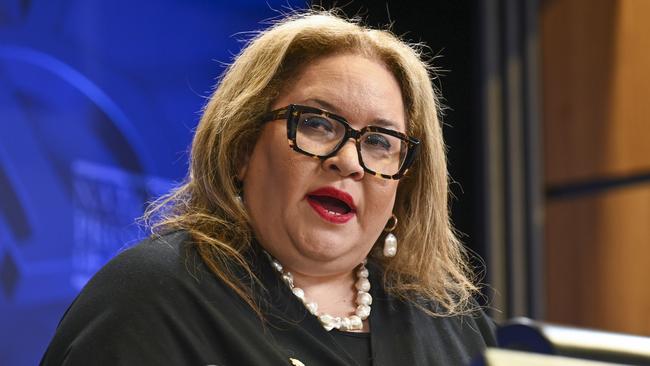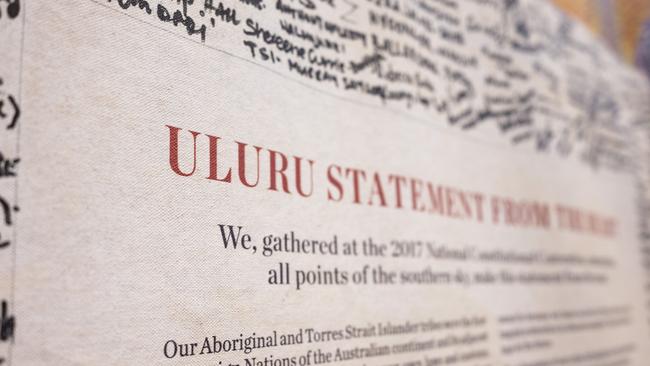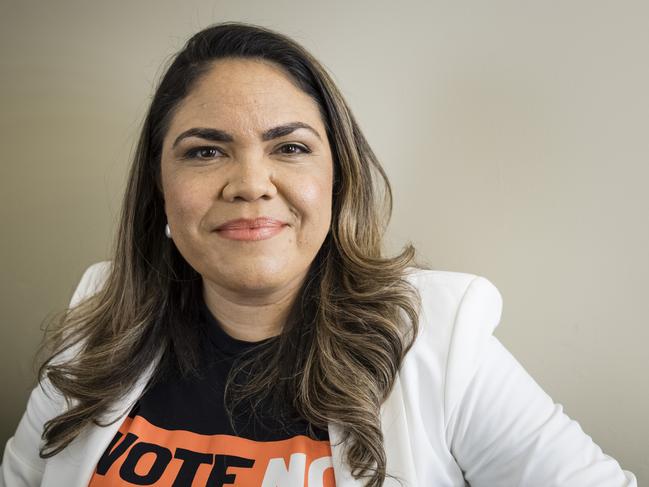Credlin: Albo not reading enough into statement behind Voice
Who signs up a country to constitutional change based on the cover and not the contents? Apparently Anthony Albanese, writes Peta Credlin.
Opinion
Don't miss out on the headlines from Opinion. Followed categories will be added to My News.
What kind of a prime minister would ask Australians to make the biggest ever proposed change to our constitution based on documents he hasn’t read?
Unfortunately, it’s the one we currently have, Anthony Albanese, who last week admitted to not reading the full 26 pages of the Uluru Statement From The Heart, even though he has committed his government to implementing it in full and even though its authors have repeatedly called upon all Australians to read it.
Just as bad is the further evidence refuting the PM’s claim that the Uluru Statement is just a one-page poster. It’s the most damning yet from none other than statement co-author, Professor Megan Davis. At the Adelaide Writers’ Festival on March 15, 2020, in an interview with Professor Clare Wright, Davis explicitly contrasted the one page poster, including artwork, with the full statement.
“The most important thing about the Uluru Statement” she said, “is it’s actually an 18 page document. It includes … the Truth Telling stories that each of the dialogues told about Australian history … and we pulled that all together in quite a lengthy … Aboriginal history of Australia”.
“But really,” she goes on, “the Uluru Statement is a very important 18 page document that I say as a constitutional lawyer is a very important constitutional document. Because it really sets out for all Australians the logic for this reform.”

This should really quash, once and for all, the Yes camp’s current claim, including from the PM, that the full Uluru Statement is no more than a set of background papers. As Davis reminds us in this interview, she is a constitutional lawyer, a legal professor no less, and she confirms the constitutional weight of the full document. It’s the strongest version of the public statements she has made at least seven times that the Uluru Statement is so much more than the PM’s one-page poster.
This should be a light bulb moment for voters: A warning sign that the proposed Voice, at the very least, is a giant leap in the dark, given that not even the Prime Minister is across the detail of Voice, Treaty, Truth. Or at least pretends that he doesn’t need to be in order to avoid questions he doesn’t want to answer before he sends Australians to the ballot box.

I was staggered when I listened to the Albanese confession last week that he hadn’t read the full Uluru document. Who signs up a country to constitutional change based on the cover and not the contents?
Melbourne radio legend Neil Mitchell was clearly taken aback when, in the course of brisk exchange about what the Voice would actually do, the PM dropped this bombshell: “I haven’t read it”.
“Why would I?” he added. “I know what the conclusion is.”
This matters because the extended Uluru Statement deals with the very issues that the Prime Minister insists that the Voice is not about, but really is. Contentious issues like treaties between the federal Government and hundreds of different Indigenous groups across the country. The Uluru Statement also says the reparations that could be a “percentage of GDP”.

In other words, tens of billions on top of the roughly $40 billion a year that governments currently spend on Indigenous Australians.
What is – and what is not – included in the Uluru Statement has become highly charged for the obvious reason that the PM has said at least 34 times that he’s not just committed to putting an Indigenous Voice into the constitution but that he‘s committed to implementing the Uluru Statement IN FULL. As revealed by an FOI application from March (that was hardly noticed until I reported it a fortnight back), the full Uluru Statement is a 26 page document calling for a Makarrata Commission, stating that “Makarrata is another word for Treaty or agreement-making” and that “it is the culmination of our agenda”. The full Statement shows that this Makarrata Commission is intended to sit above the parliament and supervise a treaty-making process between the federal Government and so-called First Nations.
As well, the full statement includes a section called Our Story, that sees the settlement of Australia as a tale of unrelieved injustice, even genocide.
Not surprisingly, the PM wants us to believe that the Uluru Statement is a genial invitation for all Australians to walk together on a journey of reconciliation rather than a massive ambit claim to atone for the original sin of British settlement. Hence his insistence that it’s just a 439 word poster. And, naturally enough, key Voice backers such as Professor Davis and Pat Anderson instantly changed their tune to support the PM even though they’d previously insisted that the Statement was the much longer version.

Only, the problem for them is that they have said too much on the record for too long, like the interview (above) in Adelaide, and can’t now plausibly rewrite history, even if many in the media are willing to let them get away with it.
Honestly, how can Megan Davis get away with this blatant revisionism? Ten days ago, she even went so far as to write in The Australian newspaper that what she’d earlier insisted in 2020 was an “important constitutional document” was now mere “transcriptions of butcher’s paper”. The only possible explanation for this U-turn is a panicked desire to rescue a PM who’s been caught out as not across the detail of the constitutional upheaval he wants us to support.
But this obvious attempt to hide the fine print of a constitutional con-job has just got much worse with the connivance of Big Tech. My Sky News editorial from August 3, highlighting the differences between the relatively benign one page statement and the full Uluru agenda, once it became a political problem for the government, was blocked by Facebook on the grounds that “fact-checkers” disagreed with it.
Instead of a link to my editorial, there was a link to a collaboration between the RMIT university and the ABC concluding that my editorial was “false” because Megan Davis and Pat Anderson now deny what they have said on the record for over six years about the full Uluru Statement. At the very least, this is a contested area where the same co-authors that the RMIT-ABC “fact-checkers” now rely on to shut me down are the same co-authors who are on the record supporting my position. In a court of law, my arguments and evidence would be heard, not censored.

And this is not Big Tech’s first bid to censor the Voice debate. Facebook had earlier blocked an Institute of Public Affairs discussion with leading No campaigner, Senator Jacinta Price; and an Advance Australia ad stating that the Voice gave some people “special rights” (again, on the authority of RMIT-ABC “fact-checkers”) even though that’s what many senior lawyers think. Politically correct censorship is going to get much worse if the Albanese government’s proposed new laws against misinformation and disinformation are passed and Big Tech faces multimillion-dollar fines for permitting free speech that some faceless official thinks might be false or misleading.
Voting No to a constitutionally entrenched Indigenous Voice is really voting Yes to constitutional equality. As proposed, the Voice would entrench race in the constitution, reinforce Indigenous separatism and make the processes of government even more complicated. That should be more than enough to have voters reject it, but the fact that the Voice campaign is already curtailing free speech should make the case against it even more compelling.
WATCH PETA ON CREDLIN ON SKY NEWS, WEEKNIGHTS AT 6PM





